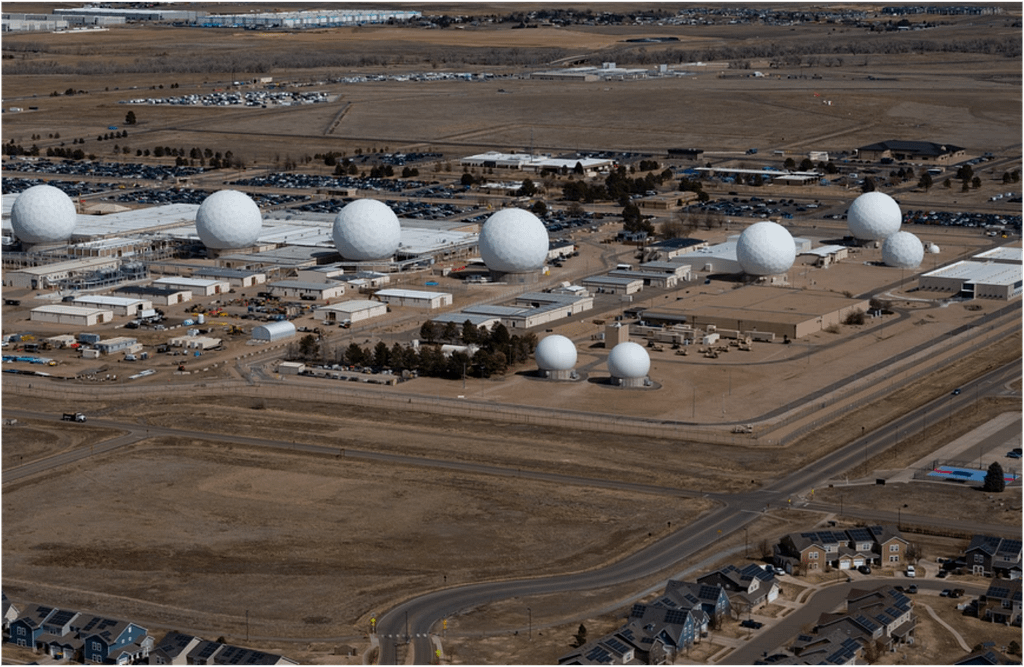PODCAST: a comprehensive chronological overview of the Schriever Space Force Base (SFB) and its associated units. It details the evolution of the base, from its origins as Falcon Air Force Station to its current designation as Schriever SFB, highlighting key dates, construction milestones, and name changes. The document also meticulously traces the lineage and transformations of the 50th Space Wing, initially a fighter unit, into its pivotal role in space operations, including the types of aircraft, missiles, and satellites it has operated throughout its history. Furthermore, the text includes biographies of significant leaders like General Bernard A. Schriever and Colonel Zachary S. Warakomski, while also listing awards and decorations earned by the 50th Space Wing, underscoring its historical contributions to both conventional and space warfare.
The 50th Space Wing (50 SW) was activated on January 30, 1992, at Falcon Air Force Base (later renamed Schriever Air Force Base), assuming responsibility for satellite control and network operations. Its primary function was to command satellites to deliver decisive global effects. The wing’s transition to satellite and network operations allowed it to add to its list of awards and accomplishments. In July 2020, the 50 SW was inactivated, and its operational missions were transferred to Space Deltas as part of the United States Space Force (USSF) reorganization, with installation management falling under the Peterson-Schriever Garrison.

The 50th Space Wing operated a variety of critical satellite systems and the Air Force Satellite Control Network (AFSCN) to provide positioning, navigation, and timing (PNT), military satellite communications (MILSATCOM), space situational awareness (SSA), and intelligence, surveillance, and reconnaissance (ISR) effects to combatant commanders.
Here are some of the critical satellite systems operated by the 50th Space Wing and their impact:
- Navstar Global Positioning System (GPS):
- The 50 SW assumed control of the GPS constellation in 1992, managing 24 satellites by 1994.
- GPS provides highly accurate positioning, navigation, and timing (PNT) to military, government, private, and commercial users.
- GPS capabilities were present in virtually every military engagement and humanitarian effort involving U.S. forces.
- During Operation IRAQI FREEDOM in 2003, crews from the 2nd Space Operations Squadron developed new techniques to enhance GPS accuracy over the Iraqi theater, and the 1st Space Operations Squadron set a record by placing a GPS satellite in orbit and completing early on-orbit checkout activities in only 11 days.
- Newer generations of GPS satellites, such as GPS III, provide a three times more accurate signal and eight times more accurate anti-jam capability, increasing support for both civilian and military users globally.
- The 2 SOPS received the Chief of Staff Team Excellence Award for their GPS operations in 2011.
- Defense Support Program (DSP):
- The 50 SW assumed control of early warning satellites in the Defense Support Program (DSP).
- The 1st Space Operations Squadron had flown this constellation since 1992, with the 2d Space Warning Squadron assuming command and control responsibility in August 2006. These satellites were designed to provide ballistic missile warnings.
- Defense Meteorological Satellite Program (DMSP):
- The 50 SW controlled the meteorological satellites comprising the DMSP.
- Control of these satellites was intended to transfer to the National Oceanic and Atmospheric Administration (NOAA) by 1998, with the 6th Space Operations Squadron at Schriever AFB operating as NOAA’s back-up operations center.
- The wing later regained responsibility for DMSP in 2010.
- Defense Satellite Communications System (DSCS):
- The 50 SW managed the DSCS constellation, which provided military and diplomatic communications.
- In 1992, the 3d Space Operations Squadron realigned a DSCS craft to provide needed communications for United Nations peacekeeping operations in Somalia under Operation RESTORE HOPE.
- During Operation IRAQI FREEDOM, the 3d Space Operations Squadron’s DSCS Block III satellites provided 80 percent of in-theater bandwidth.
- The last DSCS II satellite was placed into a super synchronous orbit in 1998, having exceeded its life expectancy.
- Milstar (Military Strategic and Tactical Relay):
- Crews of the 50th Space Wing’s 4th Space Operations Squadron accepted command authority for the Military Strategic and Tactical Relay communications system on November 1, 1994.
- During Operation IRAQI FREEDOM, the 4th Space Operations Squadron dedicated 85 percent of Milstar communications capability to the war effort, flying 14,000 sorties in the first 20 days of operations.
- The last Milstar satellite was launched in April 2003, completing the constellation, with initial operational capability declared in December 2003.
- Wideband Global SATCOM (WGS):
- The 50 SW assumed satellite control authority for the WGS spacecraft, which expanded broadband communications constellations.
- The first WGS vehicle (WGS-1) was accepted by the 3d Space Operations Squadron in April 2008.
- Tactical Satellite 3 (TacSat-3):
- The 1st Space Operations Squadron began tracking, telemetry, and commanding for this experimental satellite.
- TacSat-3 provided real-time imagery and information from sea-based buoys to U.S. combat forces, and sought to validate “plug-and-play” avionics capability.
- The satellite exceeded its mission expectancy by 20 months before operations ceased in February 2012 and it de-orbited in May 2012.
- Operationally Responsive Space – 1 (ORS-1):
- The 1st Space Operations Squadron accepted Satellite Control Authority for the first ORS satellite in September 2011. Initial and final operational capability was declared in January 2012.
- Advanced Extremely High Frequency (AEHF):
- The 4th Space Operations Squadron prepared for and accepted satellite control authority for the AEHF spacecraft, which provides protected military satellite communications.
- The first AEHF satellite (AEHF-1) experienced an anomaly after its August 2010 launch, requiring a year-long effort to bring it into its assigned geosynchronous orbit. The wing also gained control of AEHF-2, 4, 5, and 6.
- Geosynchronous Space Situational Awareness Program (GSSAP):
- These satellites provided enhanced space situational awareness capabilities over legacy systems.
- The 1st Space Operations Squadron accepted satellite control authority for the first two GSSAP satellites in September 2015, following initial operational capability declaration. SVN 3 and 4 were launched for 50 SW operation in August 2016.
- Boeing X-37B Orbital Test Vehicle (OTV):
- The 3d Space Experimentation Squadron supported the missions of the X-37B, an orbital test vehicle.
- These missions achieved record durations, with one mission ending after 718 days in space in May 2017, and another after a record-breaking 780-day mission in October 2019.
- Operationally Responsive Space-5 (ORS-5):
- The 1st Space Operations Squadron supported the launch and subsequently controlled the ORS-5 satellite, launched in August 2017.
- Midcourse Space Experiment (MSX):
- The wing assumed control of the MSX satellite in October 2000. Its disposal was initiated in July 2008.
- SKYNET (British Satellite System):
- The 3d Space Operations Squadron assumed mission planning and AFSCN scheduling responsibilities for the British SKYNET 4 constellation, which was the United Kingdom’s equivalent of the DSCS, providing military and diplomatic communications.
- Ultra-High Frequency Follow-On (UHF F/O or UFO):
- The 3d Space Operations Squadron was involved in the operation of these satellite communications centers, with responsibility for the constellation transferring to the U.S. Navy in 2000. The use of UHF Follow satellites for Global Broadcast Service (GBS) transmission was terminated in July 2017.
- Global Broadcast Service (GBS):
- The 50 SW, through its 50th Space Communications Squadron (50 SCS), provided worldwide continuous, one-way high-speed information flow over military and commercial satellites to quickly disseminate information products to deployed and in-garrison forces.
- The 50 SCS managed this $2.1 billion space-based network, providing crucial command, control, communications, computer, and intelligence (C4I) support to nine Combatant Commands and five federal agencies. They also established the first-ever GBS Continuity of Operations facility (COOP).
- Air Force Satellite Control Network (AFSCN):
- The 50th Space Wing assumed responsibility for the AFSCN, which enabled satellite controllers to “fly” satellites under their command.
- The 50th Network Operations Group (50 NOG) and its squadrons commanded this $6.2 billion network, which included 16 ground antennas supporting 185 satellites and an average of 19 space vehicle launches per year.
- The AFSCN assured command and control (C2) at satellite ground sites, increased the nation’s space capabilities, and monitored all network communications paths for seven Geographically Separated Units (GSUs).
- The 50 NOG was considered a pathfinder for USAF Defensive Cyber Operations as it developed processes and employed new tools to secure the AFSCN, establishing a 24/7 Cyber Defensive Operations Center that eradicated 13,000 cyber threats.
